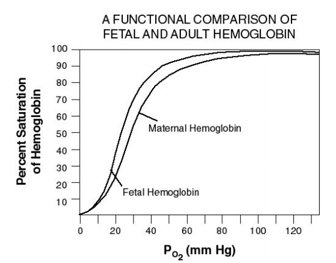Refer to the graph below.

A. At a PO2 of 80 mm Hg, which type of hemoglobin binds more oxygen?
B. At a PO2 of 40 mm Hg, which type of hemoglobin has released more oxygen to the cell?
C. Explain the significance of the differences in fetal and maternal hemoglobin affinity.
D. If a worm lived in low oxygen mud flats where the PO2 is 60 mm Hg, which type of hemoglobin would be
better for it to have? Explain.
A. Fetal hemoglobin has a higher affinity for oxygen than maternal hemoglobin at that oxygen pressure.
B. Maternal hemoglobin releases oxygen more readily than fetal hemoglobin at that oxygen pressure.
C. The higher affinity of fetal hemoglobin for oxygen ensures a net transfer of oxygen from the maternal blood to the fetal blood in the placenta. While unloading from fetal hemoglobin to fetal tissues is less favorable due to the higher affinity, the high rate of oxygen consumption in fetal tissues and consequent low oxygen pressure ensures unloading will occur.
D. The fetal form of hemoglobin would be better in this situation, because it has a higher affinity for the oxygen at this pressure. Thus, the worm's blood would become more saturated, and more oxygen would then be available for the worm's cells.
You might also like to view...
Drugs that block the beta-one adrenergic receptors will
A) increase heart rate. B) decrease heart rate. C) increase contractility. D) increase cardiac output. E) decrease the end-systolic volume.
Where is the spinous process in the diagram?
a) B b) C c) D d) E e) F
A smooth, sustained contraction is called ________.
What will be an ideal response?
Both "turn on" factors (hormonal, humoral, and neural stimuli) and "turn off" factors (feedback inhibition and others) may be modulated by the activity of the nervous system
Indicate whether the statement is true or false